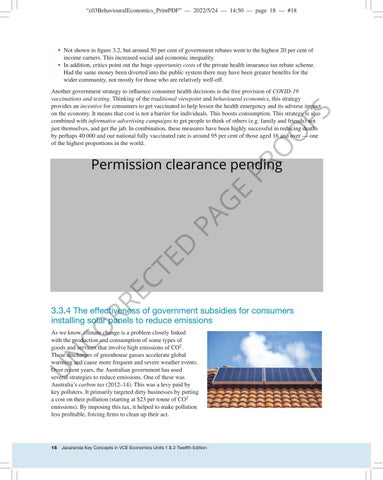“c03BehaviouralEconomics_PrintPDF” — 2022/5/24 — 14:50 — page 18 — #18
• Not shown in figure 3.2, but around 50 per cent of government rebates went to the highest 20 per cent of
income earners. This increased social and economic inequality. • In addition, critics point out the huge opportunity costs of the private health insurance tax rebate scheme.
Had the same money been diverted into the public system there may have been greater benefits for the wider community, not mostly for those who are relatively well-off.
O
O
FS
Another government strategy to influence consumer health decisions is the free provision of COVID-19 vaccinations and testing. Thinking of the traditional viewpoint and behavioural economics, this strategy provides an incentive for consumers to get vaccinated to help lessen the health emergency and its adverse impact on the economy. It means that cost is not a barrier for individuals. This boosts consumption. This strategy is also combined with informative advertising campaigns to get people to think of others (e.g. family and friends) not just themselves, and get the jab. In combination, these measures have been highly successful in reducing deaths by perhaps 40 000 and our national fully vaccinated rate is around 95 per cent of those aged 16 and over — one of the highest proportions in the world.
CO RR EC
TE
D
PA
G
E
PR
Permission clearance pending
3.3.4 The effectiveness of government subsidies for consumers installing solar panels to reduce emissions
U
N
As we know, climate change is a problem closely linked with the production and consumption of some types of goods and services that involve high emissions of CO2 . These discharges of greenhouse gasses accelerate global warming and cause more frequent and severe weather events. Over recent years, the Australian government has used several strategies to reduce emissions. One of these was Australia’s carbon tax (2012–14). This was a levy paid by key polluters. It primarily targeted dirty businesses by putting a cost on their pollution (starting at $23 per tonne of CO2 emissions). By imposing this tax, it helped to make pollution less profitable, forcing firms to clean up their act.
18
Jacaranda Key Concepts in VCE Economics Units 1 & 2 Twelfth Edition





















































